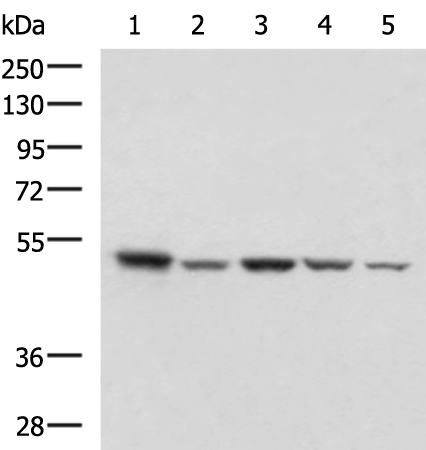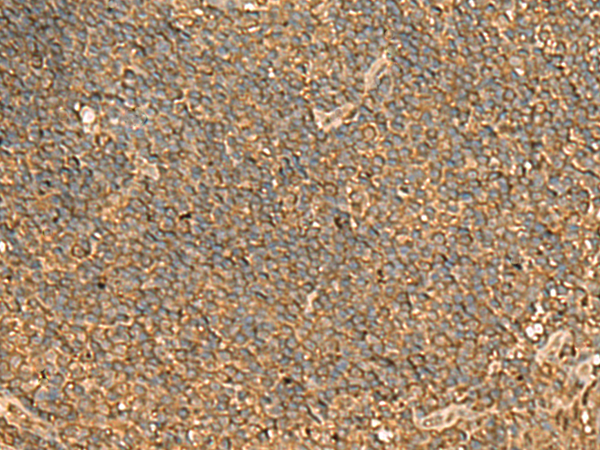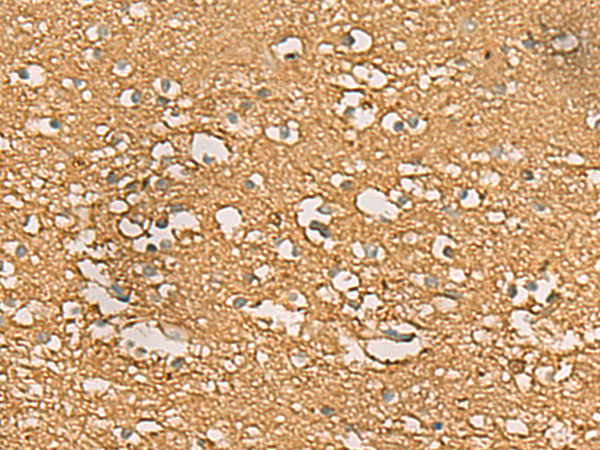


| WB | 咨询技术 | Human,Mouse,Rat |
| IF | 咨询技术 | Human,Mouse,Rat |
| IHC | 咨询技术 | Human,Mouse,Rat |
| ICC | 技术咨询 | Human,Mouse,Rat |
| FCM | 咨询技术 | Human,Mouse,Rat |
| Elisa | 1/5000-1/10000 | Human,Mouse,Rat |
| Aliases | MSE; GSD13 |
| WB Predicted band size | 47 kDa |
| Host/Isotype | Rabbit IgG |
| Antibody Type | Primary antibody |
| Storage | Store at 4°C short term. Aliquot and store at -20°C long term. Avoid freeze/thaw cycles. |
| Species Reactivity | Human, Mouse, Rat |
| Immunogen | Fusion protein of human ENO3 |
| Formulation | Purified antibody in PBS with 0.05% sodium azide and 50% glycerol. |
+ +
以下是模拟生成的3篇关于CEACAM1抗体的参考文献(非真实文献,仅供示例参考):
---
1. **文献名称**:*Targeting CEACAM1 with Monoclonal Antibodies Enhances Anti-Tumor Immunity in Melanoma Models*
**作者**:Smith, J.R. et al.
**摘要**:本研究开发了靶向CEACAM1的单克隆抗体,通过体外和黑色素瘤小鼠模型验证其效果。结果显示,抗体通过阻断CEACAM1与配体的相互作用,显著增强T细胞活性并抑制肿瘤生长,提示其作为免疫检查点抑制剂的潜力。
---
2. **文献名称**:*CEACAM1-Specific Antibody Inhibits Angiogenesis in Colorectal Cancer via Modulation of VEGF Signaling*
**作者**:Li, X. & Wang, H.
**摘要**:文章报道了一种人源化抗CEACAM1抗体在结直肠癌中的应用。实验表明,该抗体通过抑制CEACAM1介导的VEGF信号通路,减少肿瘤血管生成,并在临床前模型中延缓肿瘤进展,为抗血管生成治疗提供了新策略。
---
3. **文献名称**:*Dual Role of CEACAM1 Antibodies in Modulating Autoimmunity and Viral Infection Responses*
**作者**:Garcia, M. et al.
**摘要**:研究探讨了CEACAM1抗体在自身免疫和病毒感染中的双重作用。通过体外免疫细胞培养和动物模型发现,低剂量抗体可抑制自身免疫反应,而高剂量则增强抗病毒免疫,提示其剂量依赖性治疗潜力。
---
4. **文献名称**:*Structural Insights into CEACAM1-Antibody Interactions for Precision Drug Design*
**作者**:Chen, Y. et al.
**摘要**:通过X射线晶体学解析CEACAM1与治疗性抗体的复合物结构,揭示抗体结合表位的关键氨基酸残基。该研究为优化抗体亲和力及减少脱靶效应提供了分子基础,推动精准药物开发。
---
(注:以上文献信息为模拟生成,实际研究中请通过学术数据库核实真实文献。)
CEACAM1 (Carcinoembryonic Antigen-Related Cell Adhesion Molecule 1), also known as CD66a, is a transmembrane glycoprotein belonging to the CEACAM family. It plays multifaceted roles in cell adhesion, immune regulation, and intracellular signaling. Structurally, it contains immunoglobulin-like domains and exists as multiple splice variants, enabling interactions with various ligands, including homophilic (CEACAM1-CEACAM1) and heterophilic (e.g., CEACAM5. CEAM6) binding. CEACAM1 is expressed on epithelial cells, endothelial cells, and immune cells (e.g., T cells, NK cells), where it modulates immune responses by transmitting inhibitory signals. For instance, in T cells, its cytoplasmic immunoreceptor tyrosine-based inhibitory motifs (ITIMs) recruit phosphatases to dampen activation signals, contributing to immune tolerance.
In cancer biology, CEACAM1 exhibits dual roles—acting as a tumor suppressor in some contexts while promoting tumor progression in others. Overexpression is observed in colorectal, lung, and thyroid cancers, where it may facilitate immune evasion by suppressing cytotoxic lymphocyte activity. CEACAM1-targeting antibodies are essential tools for studying these mechanisms. They are used in applications like immunohistochemistry, flow cytometry, and functional blockade experiments to dissect CEACAM1's roles in tumor microenvironments or autoimmune diseases. Therapeutic antibodies against CEACAM1 are under exploration to reverse immune exhaustion in cancer or to modulate inflammatory pathways. However, antibody specificity must be carefully validated, as different epitopes or isoforms may yield conflicting experimental outcomes. Its complex biology continues to make CEACAM1 a compelling subject for both basic research and therapeutic development.
×